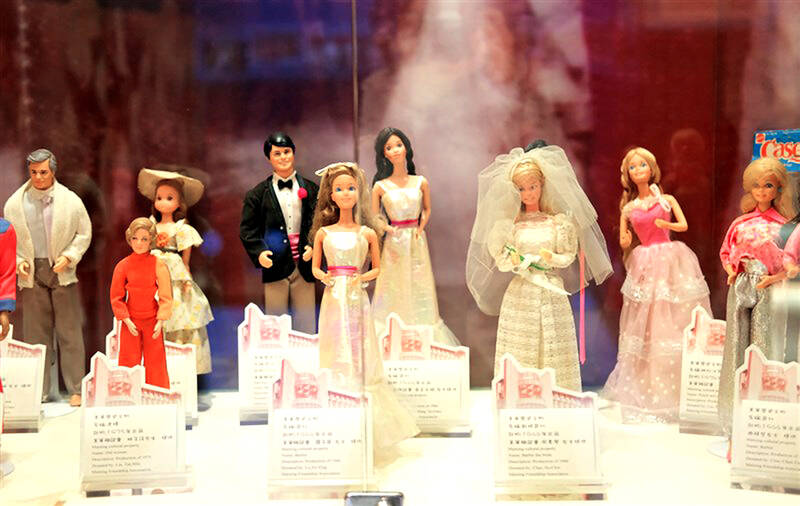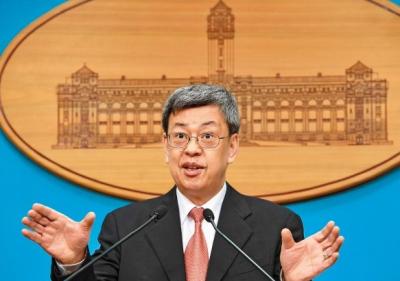Box office smash Barbie, the summer viral hit about the much-loved Mattel doll that many spent their childhoods playing with, has received eight nominations for this year’s Academy Awards, which is to be held on March 10.
The famous plastic doll, with her slender figure and chic fashion sense, achieved global commercial success following her 1959 debut and remains one of the most popular toys to date.
However, the brand’s success story cannot fully be told without paying tribute to a group of factory workers in a small northwestern Taiwan town, who, in the 1970s produced 80 percent of the world’s Barbie dolls.

Photo: CNA
Hsu Chu-lien (許菊蓮), a petite and lively woman in her late 60s, was once part of the 8,000-strong workforce at Mattel’s manufacturing base — the Meining (美寧) factory — established in 1967 in what is now New Taipei City’s Taishan District (泰山).
“There were over 3,000 employees at the factory, but including home-based subcontractors, about 8,000 of us received regular paychecks,” Hsu said.
She joined Mattel’s doll manufacturing plant in 1972 when she was 17, shortly after graduating from junior high school in Miaoli County.
She worked in the sewing department for six years, spending her days piecing together tiny dresses and accessories for the iconic doll and living in the company’s dormitory.
During its 20 years of operations until its closure in 1987, the Meining factory — a joint venture between Mattel and a Taiwanese company led by plastics manufacturing magnate Chao Ting-tsung (趙廷箴) — churned out nearly 1 billion dolls.
Mattel chose Taiwan as its location for making the dolls because of government incentives and cheap labor, according to a China Times report published in November 1967, months after the factory began operations.
However, all of the toys produced in the factory’s early years were exported and it was not until 1982 that the first Barbie model — a doll with a pink polka-dot top and white chiffon pettiskirt — was available in Taiwanese market.
Barbie was popular among the predominantly female factory workforce, and Hsu was no exception.
“Back then, there were not many dolls in the [Taiwanese] market,” Hsu said. “Barbie is so beautiful, who wouldn’t like her? Every girl liked her.”
It never occurred to her that she would one day be able to buy one, Hsu said, adding that a Barbie doll was a luxury that a factory worker with a meager monthly salary of NT$1,000 could not afford.
Still, the doll was so coveted that some were willing to risk swiping parts of the doll, a piece at a time, out of the factory, despite tight security checks, said Pai Li- ping (白麗萍), who worked at the Mattel factory for two years.
“Honestly, everyone was trying to sneak out bits of Barbie,” Pai said. “She is so beautiful and glamorous.”
“I used to put small parts in my lunchbox to avoid being caught by security,” Pai said, adding that she kept the dolls until recently.
“From a very young age, I felt this company was different,” she said about Mattel.
Pai, now in her 50s, continues to cherish the memories of sneaking into the Mattel complex as a child, clutching just a stool, as she tried to catch an outdoor movie screening, one of the many entertainment perks provided to employees and their families.
She joined the factory when she was 18, working in different departments for the next two years, from hair transplantation to sewing and eventually to molding, where she would meet her future husband.
Many of Pai’s colleagues, who joined the company in early adulthood, had similar experiences to her and marked some of the most important moments of their lives — like getting married or buying a house — while working at the company, the Taishin District Office said.
Pai and Hsu have no desire to put the years spent working at the factory behind them, despite the toy giant relocating its manufacturing base to China about four decades ago.
Pai, who works at a beauty salon, remains a member of the Meining Friendship Group, which organizes social gatherings for those who used to work at the plant.
Hsu, who is retired, has volunteered for 16 years at the Taishan Doll Museum, a small exhibition space in the New Taipei City town displaying dozens of the Barbie dolls and toys produced at the factory.
Established in 2004, the museum is dedicated to the time when Taishan, a small town where most people worked in farming, prospered by manufacturing Mattel dolls.
The museum, run by the district office, has sought to carve out its legacy for years in the town that is booming with various industries these days.
Holding workshops on producing doll clothes is part of that effort, said workshop lecturer Shami Kuo (郭雪美), who is an enthusiastic Barbie collector.
Students from all backgrounds have enrolled in the annual three-month-long workshop to learn how to produce garments for Barbie, Kuo said.
However, the focus is not on typical Barbie attire, but on exquisite pieces reflecting Taiwanese culture; for example, outfits worn by chiefs of Taiwanese Indigenous groups, she said.
The goal is to “celebrate Taiwan’s cultural heritage” as well as the beloved doll, Kuo said.

Several Chinese Nationalist Party (KMT) officials including Chairman Eric Chu (朱立倫) are to be summoned for questioning and then transferred to prosecutors for holding an illegal assembly in Taipei last night, the Taipei Police said today. Chu and two others hosted an illegal assembly and are to be requested to explain their actions, the Taipei City Police Department's Zhongzheng (中正) First Precinct said, referring to a protest held after Huang Lu Chin-ju (黃呂錦茹), KMT Taipei's chapter director, and several other KMT staffers were questioned for alleged signature forgery in recall petitions against Democratic Progressive Party (DPP) legislators. Taipei prosecutors had filed

Taiwan would welcome the return of Honduras as a diplomatic ally if its next president decides to make such a move, Minister of Foreign Affairs Lin Chia-lung (林佳龍) said yesterday. “Of course, we would welcome Honduras if they want to restore diplomatic ties with Taiwan after their elections,” Lin said at a meeting of the legislature’s Foreign Affairs and National Defense Committee, when asked to comment on statements made by two of the three Honduran presidential candidates during the presidential campaign in the Central American country. Taiwan is paying close attention to the region as a whole in the wake of a

NEW WORLD: Taiwan is pursuing innovative approaches to international relations through economics, trade and values-based diplomacy, the foreign minister said Taiwan would implement a “three-chain strategy” that promotes democratic values in response to US tariffs, Minister of Foreign Affairs Lin Chia-lung (林佳龍) said. Taiwan would aim to create a “global democratic value chain,” seek to capitalize on its position within the first island chain and promote a “non-red supply chain,” Lin was quoted as saying in the ministry’s written report to the Legislative Yuan submitted ahead of the legislature’s Foreign Affairs and National Defense Committee meeting slated for today. The Ministry would also uphold a spirit of mutual beneficial collaboration, maintaining close communication and consultations with Washington to show that Taiwan-US cooperation

President William Lai (賴清德) has appointed former vice president Chen Chien-jen (陳建仁) to attend the late Pope Francis’ funeral at the Vatican City on Saturday on his behalf, the Ministry of Foreign Affairs said today. The Holy See announced Francis’ funeral would take place on Saturday at 10am in St Peter’s Square. The ministry expressed condolences over Francis’ passing and said that Chen would represent Taiwan at the funeral and offer condolences in person. Taiwan and the Vatican have a long-standing and close diplomatic relationship, the ministry said. Both sides agreed to have Chen represent Taiwan at the funeral, given his Catholic identity and